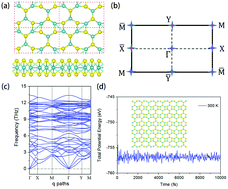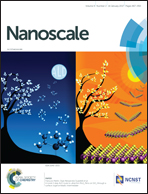Topological insulating states in 2D transition metal dichalcogenides induced by defects and strain†
Abstract
First-principles calculations and extensive analyses reveal that the H phase of two-dimensional (2D) transition metal dichalcogenides (TMDs) can be tuned to topological insulators by introducing square–octagon (4–8) defects and by applying equi-biaxial tensile strain simultaneously. The 2D structure composed of hexagonal rings with 4–8 defects, named sho-TMD, is dynamically and thermally stable. The critical equi-biaxial tensile strain for the topological phase transition is 4%, 6%, and 4% for sho-MoS2, sho-MoSe2 and sho-WS2, respectively, and the corresponding nontrivial band gap induced by the spin–orbit coupling is 2, 8, and 22 meV, implying the possibility of observing the helical conducting edge states that are free of backscattering in experiment. It is equally interesting that the size of the energy band gap of the H-phase can be flexibly tuned by changing the concentration of 4–8 defects while the feature of the quasi-direct band gap semiconductor remains. These findings add additional traits to the TMD family, and provide a new strategy for engineering the electronic structure and the band topology of 2D TMDs for applications in nanoelectronics and spintronics.


 Please wait while we load your content...
Please wait while we load your content...